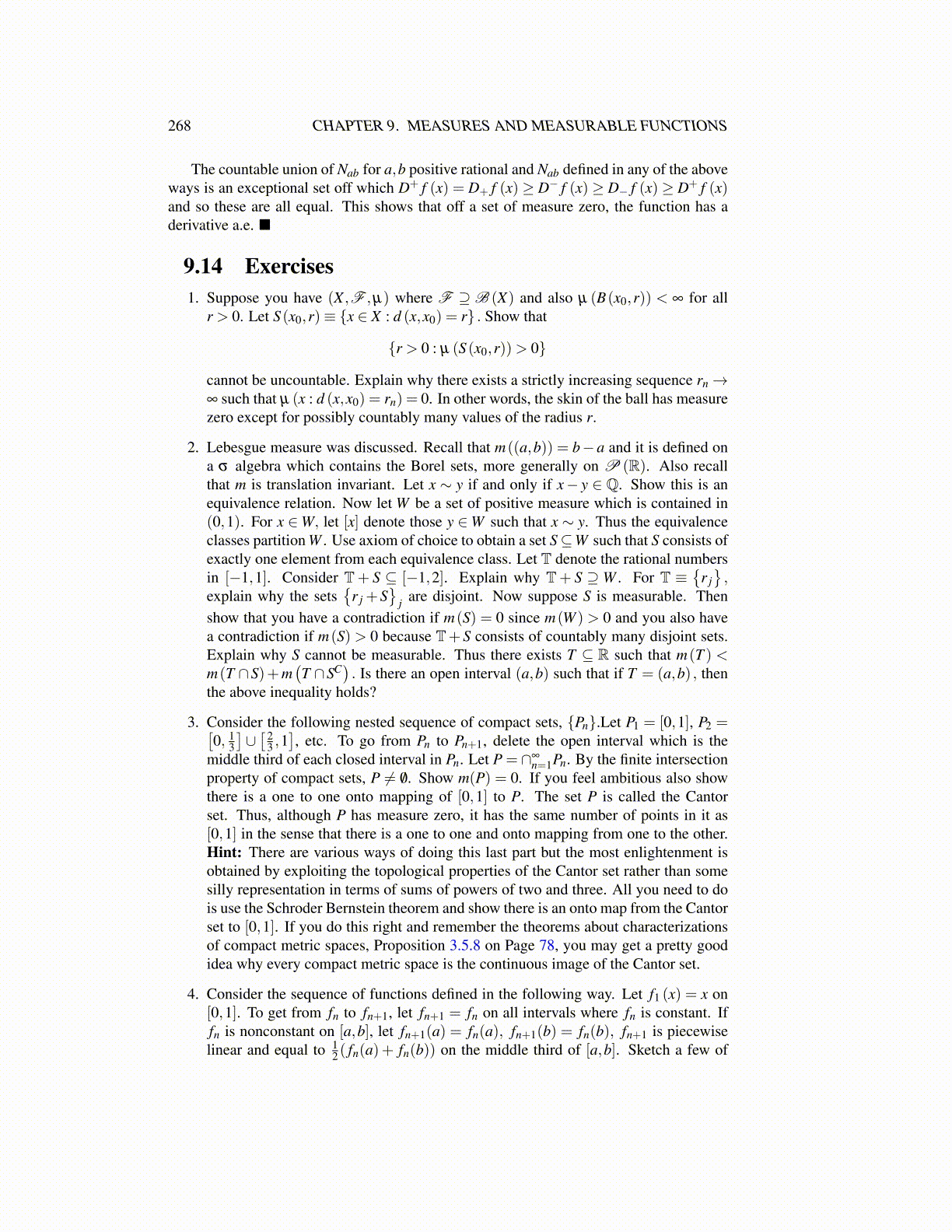
268 CHAPTER 9. MEASURES AND MEASURABLE FUNCTIONS
The countable union of Nab for a,b positive rational and Nab defined in any of the aboveways is an exceptional set off which D+ f (x) = D+ f (x) ≥ D− f (x) ≥ D− f (x) ≥ D+ f (x)and so these are all equal. This shows that off a set of measure zero, the function has aderivative a.e. ■
9.14 Exercises1. Suppose you have (X ,F ,µ) where F ⊇ B (X) and also µ (B(x0,r)) < ∞ for all
r > 0. Let S (x0,r)≡ {x ∈ X : d (x,x0) = r} . Show that
{r > 0 : µ (S (x0,r))> 0}
cannot be uncountable. Explain why there exists a strictly increasing sequence rn→∞ such that µ (x : d (x,x0) = rn) = 0. In other words, the skin of the ball has measurezero except for possibly countably many values of the radius r.
2. Lebesgue measure was discussed. Recall that m((a,b)) = b−a and it is defined ona σ algebra which contains the Borel sets, more generally on P (R). Also recallthat m is translation invariant. Let x ∼ y if and only if x− y ∈ Q. Show this is anequivalence relation. Now let W be a set of positive measure which is contained in(0,1). For x ∈W, let [x] denote those y ∈W such that x ∼ y. Thus the equivalenceclasses partition W . Use axiom of choice to obtain a set S⊆W such that S consists ofexactly one element from each equivalence class. Let T denote the rational numbersin [−1,1]. Consider T+ S ⊆ [−1,2]. Explain why T+ S ⊇W . For T ≡
{r j},
explain why the sets{
r j +S}
j are disjoint. Now suppose S is measurable. Thenshow that you have a contradiction if m(S) = 0 since m(W ) > 0 and you also havea contradiction if m(S) > 0 because T+ S consists of countably many disjoint sets.Explain why S cannot be measurable. Thus there exists T ⊆ R such that m(T ) <m(T ∩S)+m
(T ∩SC
). Is there an open interval (a,b) such that if T = (a,b) , then
the above inequality holds?
3. Consider the following nested sequence of compact sets, {Pn}.Let P1 = [0,1], P2 =[0, 1
3
]∪[ 2
3 ,1], etc. To go from Pn to Pn+1, delete the open interval which is the
middle third of each closed interval in Pn. Let P = ∩∞n=1Pn. By the finite intersection
property of compact sets, P ̸= /0. Show m(P) = 0. If you feel ambitious also showthere is a one to one onto mapping of [0,1] to P. The set P is called the Cantorset. Thus, although P has measure zero, it has the same number of points in it as[0,1] in the sense that there is a one to one and onto mapping from one to the other.Hint: There are various ways of doing this last part but the most enlightenment isobtained by exploiting the topological properties of the Cantor set rather than somesilly representation in terms of sums of powers of two and three. All you need to dois use the Schroder Bernstein theorem and show there is an onto map from the Cantorset to [0,1]. If you do this right and remember the theorems about characterizationsof compact metric spaces, Proposition 3.5.8 on Page 78, you may get a pretty goodidea why every compact metric space is the continuous image of the Cantor set.
4. Consider the sequence of functions defined in the following way. Let f1 (x) = x on[0,1]. To get from fn to fn+1, let fn+1 = fn on all intervals where fn is constant. Iffn is nonconstant on [a,b], let fn+1(a) = fn(a), fn+1(b) = fn(b), fn+1 is piecewiselinear and equal to 1
2 ( fn(a)+ fn(b)) on the middle third of [a,b]. Sketch a few of